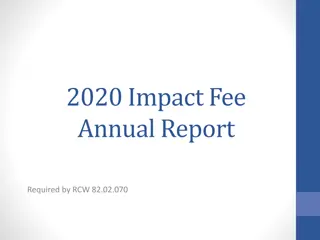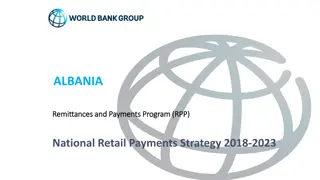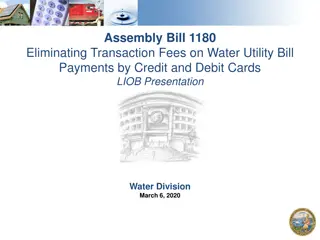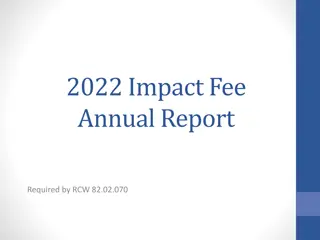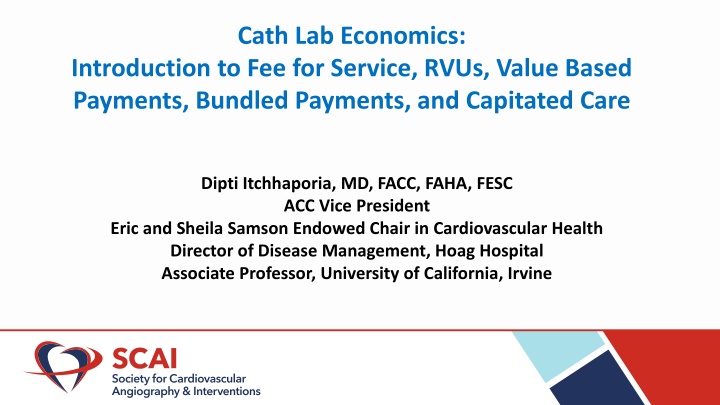
Cath Lab Economics: Fee for Service, RVUs, Value Based Payments
Explore the intricacies of Cath Lab Economics in healthcare, covering Fee for Service, RVUs, Value Based Payments, Bundled Payments, and more. Learn about Medicare's Resource-Based Relative Value System (RBRVS) and the calculation of payments. Dive into the concept of Value-Based Purchasing and its impact on cost and quality performance.
Download Presentation

Please find below an Image/Link to download the presentation.
The content on the website is provided AS IS for your information and personal use only. It may not be sold, licensed, or shared on other websites without obtaining consent from the author. If you encounter any issues during the download, it is possible that the publisher has removed the file from their server.
You are allowed to download the files provided on this website for personal or commercial use, subject to the condition that they are used lawfully. All files are the property of their respective owners.
The content on the website is provided AS IS for your information and personal use only. It may not be sold, licensed, or shared on other websites without obtaining consent from the author.
E N D
Presentation Transcript
Cath Lab Economics: Introduction to Fee for Service, RVUs, Value Based Payments, Bundled Payments, and Capitated Care Dipti Itchhaporia, MD, FACC, FAHA, FESC ACC Vice President Eric and Sheila Samson Endowed Chair in Cardiovascular Health Director of Disease Management, Hoag Hospital Associate Professor, University of California, Irvine
Disclosures None
Agenda Fee For Service in Medicare (and most payers) Value-Based Payments Bundled Payments Capitated Payments
Medicare Resource Based Relative Value System (RBRVS) Standardized physician payment schedule Most public and private payors utilize the Medicare RBRVS The cost of providing each service is divided into three components Physician Work Practice Expense Professional Liability Insurance
Medicare Resource Based Relative Value System(RBRVS) Payments calculated by multiplying the combined costs of a service by a conversion factor (a monetary amount that is determined by the Centers for Medicare and Medicaid Services) Payments are also adjusted for geographical differences in resource costs through geographic practice cost index (GPCI)
Calculating Payment The general formula for calculating Medicare payment amount for is expressed as: Total RVU = [(work RVU x work GPCI) + (practice expense RVU x practice expense GPCI) (malpractice RVU x malpractice GPCI)] Total RVU x Conversion Factor = Medicare Payment A geographic practice cost index (GPCI) has been established for every Medicare payment locality for each of the three components of a procedure's relative value unit (i.e., the RVUs for work, practice expense, and malpractice)
Value-Based Purchasing Linking payments to improved cost and quality performance It attempts to reduce inappropriate care and to identify and reward the best- performing providers and facilities. Programs at both the clinician and facility levels Programs vary Pay-for-reporting vs. pay-for-performance Risk sharing (upside only; two-sided) Payers are committed to moving value-based purchasing forward
Bundled Payment Basics Provides a single amount of money for treatment by one or more providers during an episode of care Payments made at the participant level (e.g., hospital, group practice, convener) and distributed among clinicians and those involved in care of the population Emphasis on care coordination Being explored by many payers (Medicare, Medicaid, commercial) Medicare s BPCI Advanced program is currently in Model Year 3 and allows for voluntary participation Services still paid based on fee-for-service model with retrospective reconciliation Examples of CV Episodes Percutaneous Coronary Intervention CABG Cardiac Arrythmia ICD Implantation Acute Myocardial Infarction Heart Failure
Episode Trigger: inpatient anchor admission/diagnosis (MS-DRG), or outpatient service (CPT/HCPCS code) InpatientStay/Outpatient Service Physician services (inpatient/outpatient) Hospital services Pre- Included Post-Discharge/Service Costs Admission Post-acute, rehab, home care Readmissions Most episodes run over 90 days post discharge/service Some payers have implemented episodes of up to 365 days Payment based on performance against a target price, adjusted by quality performance Programs can include upside and/or downside risk
Capitated Payments A fixed payment per beneficiary paid in advance (often monthly) Typically covering routine and primary care services; additional payments may be made for imaging and subspecialty referrals Agreements made directly between clinicians and payers (managed care contracts) or between multiple payers and clinicians (Medicare Advantage) Payments are risk-adjusted based on beneficiary population Examples of Capitated Models Medicare Advantage Direct Contracting Primary Care First













